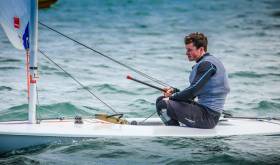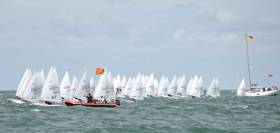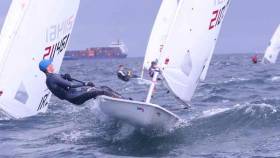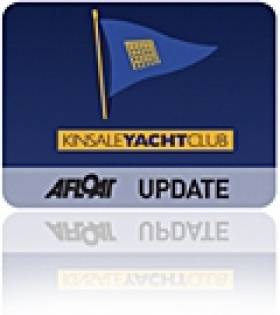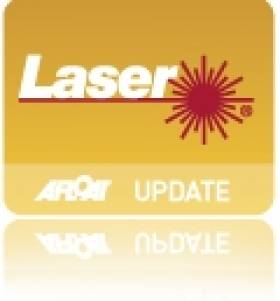Displaying items by tag: 47
Spain's Joan Ravie Leads Boys Division of Laser 4.7 Youth World Championships at Dun Laoghaire Harbour
A second day of light and shifty moderate winds completed two more qualifying rounds at the Laser/ILCA 4.7 Youth World Championships at Dun Laoghaire Harbour.
According to provisional results, the 149 boat boy's division is being led overnight by Spain's Joan Ravie followed by Alexandros Eleftheriadis of Greece with Daniel Cardona Balsa (ESP) staying third.
The top Irish performer in the boys fleet is Howth Yacht Club Optimist ace Rocco Wright who took a seventh in race four to be 51st overall.
Ravie showed real class to take two first-place finishes to move to the of the leader board.
A lighter breeze of 8-10 kts started the day at 245 degrees and backed around through to 150 as the day progressed.
The girl's division is led by Croatia's Petra Marednic with Emma Mattiv (ITA) in second and Spain's Claudia Adán Lledó (CRO) is lying third. The top Irish girl is Anna O'Connor in 36th place in the 80-boat fleet.
The reigning ILCA 4 Girls European Champion and leader from the opening day, Annemijn Algra (NED) slipped to sixth.
229 boys and girls are competing from 31 different countries for the overall prize that is being hosted jointly by the harbour's National Yacht Club and Royal St. George Yacht Clubs.
The organisers say it is one of the largest international sporting events taking place in Ireland this year.
Both boys and girls divisions have completed a full schedule of four races on separate Dublin Bay race courses
Both divisions compete for another day in the qualifying series and a further three days in the finals series to eventually decide who will be crowned the 2021ILCA 4.7 World Champion.
Boys results are here for and girls here
Racing continues from 10:30 am with three final qualifying races
East coast sailors emerged top of the three Laser divisions after a very tricky day at sea at the Rush Sailing Club hosted Leinster Championships writes our special correspondent.
Three races sailed bringing in a discard. Overall results, subject to protest, are downloadable below.
2020 Olympic campaigner Liam Glynn from Ballyholme Yacht Club, a former Topper World Champion, was the winner by four points of the 19–boat standard rig division when he overtook the host club's overinght leader Alan Ruigrok.
In the Radial division, Wexford Boat Club's Ronan Wallace was the winner. The 4.7 division was won by Tom Higgins of the Royal St. George Yacht Club.
Today's breeze was shifty with very strong rain squalls. There was a good 15–18 knots of mean wind with gusts past 23-25 knots. There was a 'nasty' sea state and a swell, not the same direction as the breeze. A wind blown chop on top of the swell made it 'like a washing machine', according to one competitor.
Rush race management was generally good but a little bit slow between races, according to some sailors. Organisation ashore was excellent, however.
The Irish Laser 4.7 ISA squad have arrived home from the World Championships in Belgium.
It proved to be a great learning experience for the Irish team many of whom were competing in their first international Laser event.
The wind conditions ranged from light to windy and the sailors had to contend with large sea's and strong tidal flows. Both girls qualified for the Gold fleet and produced strong overall results with Clare Gorman 16th overall and Eve McMahon 19th (8th under 16) in the fleet of 115 Girls.
Two of the boys, Tom Higgins and Michael O'Suilleabhain qualified for the gold fleet and both recorded top three individual race finishes, the highlight of which was Tom's win in race six.
Lynch, McMahon & Higgins Crowned Ulster Laser Champions at Royal North of Ireland Yacht Club
Ireland's youngest ever Olympic helmsman won three of six races to be crowned Ulster Laser Champion yesterday at Royal North of Ireland. Finn Lynch, of the National Yacht Club, had a four point margin with six top three results but was chased hard by Ballyholme's Liam Glynn, who also had a consistent score sheet with five results in the top three to finish on 11 points. Kinsale Yacht Club's Darragh O'Sullivan was one point back to take third in the 13–boat fleet. Both Lynch and Glynn are on the Tokyo 2020 campaign trail, and benefited from a week of competition at the Sailing World Cup in Hyeres immediately before the Ulster event.
Full results in each division are downloadable below.
The breeze on Belfast Lough held very well over the weekend despite fears to the contrary. At eight to 13 knots, a mainly easterly wind had predictable shifts with a short and choppy sea for the combined turnout of 116–boats in three divisions.
As Afloat.ie reported earlier, there were not many surprises in the six–race Radial division with Howth's Ewan McMahon staying top of the 32–boat fleet. Wexford Boat Club's Ronan Wallace was second with Aoife Hopkins of Howth Yacht Club third. A visting Norwegian girl Elnan Flotoft finished sixth.
Royal St. George's Tom Higgins was very quick in the 4.7 division with a scoresheet resembling Finn Lynch's. Higgins, a past UK and Irish Optimist Champion, had three race wins to be seven points clear of club mate Jack Fahy. Kinsale's Michael Caroll was third in the 24–boat fleet.
Day Two of the ISA Youth Sailing Pathway National Championships and Optimist Trials saw all of the fleets afloat for the first time with over 200 sailors visiting Ballyholme Yacht Club.
With a stronger breeze than yesterday averaging 12-14 knots but peaking just over 20 knots, fitness and stamina were important especially in the Laser Radial fleet where Ewan McMahon and Johnny Durcan showed the form expected with Ewan winning the first 2 races and Johnny the latter. The Radial fleet were a bit excitable in the first race of the day with 3 general recalls and Johnny earned himself a BFD dropping him to third overall. Henry Higgins splits the two of them overall. Sally Bell continues to lead the ladies although she copied Johnny's BFD in the first.
There was lots of tight racing in the 420 class with little separating the first few at the finishes. Wexford Harbour's duo of Geoff Power and James McCann however managed to escape at the end of each race with three bullets for the day, and now leads overall.
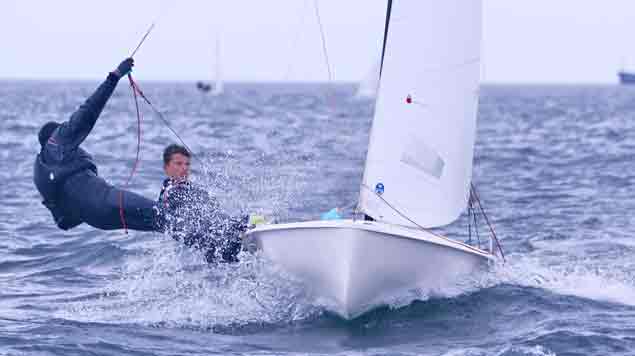 420 leaders Geoff Power James McCann from Waterford Harbour Sailing Club Photo: Simon McIlwaine
420 leaders Geoff Power James McCann from Waterford Harbour Sailing Club Photo: Simon McIlwaine
The Optimist fleet had four races today which tested all of the youngsters especially with a squall at the start of the last race with all but only a few getting too tired in the testing conditions to finish the last race.
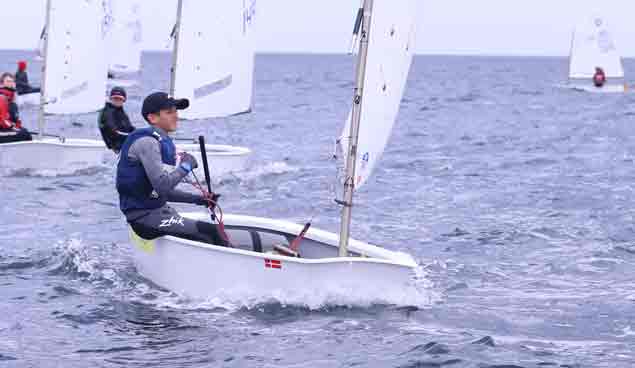 Optimist sailor Justin Lucas. Photo: Simon McIlwaine Photo: Simon McIlwaine
Optimist sailor Justin Lucas. Photo: Simon McIlwaine Photo: Simon McIlwaine
The Laser 4.7 fleet started their racing today with Sally Bell's younger brother Harry from Royal North Ireland winning the first race. Jack Fahy won the second race and Clare Gorman the last but the most consistent and now leads overall with a 4,2,1
 Clare Gorman of the National Yacht Club leads the Laser 4.7s Photo: Simon McIlwaine
Clare Gorman of the National Yacht Club leads the Laser 4.7s Photo: Simon McIlwaine
Another family affair, Jack Fahy's sister Kate showed great form in the Topper fleet which was also racing for their first day lying second overall from East Down's Sarah Jennings. Rob Keal won the first two races however and leads overall with 1,1,4. The Topper 4.2 fleet saw a local fight between Lewis Thompson, Hannah Dadley-Young and Josh McGregor with Lewis also getting 3 bullets for the day.
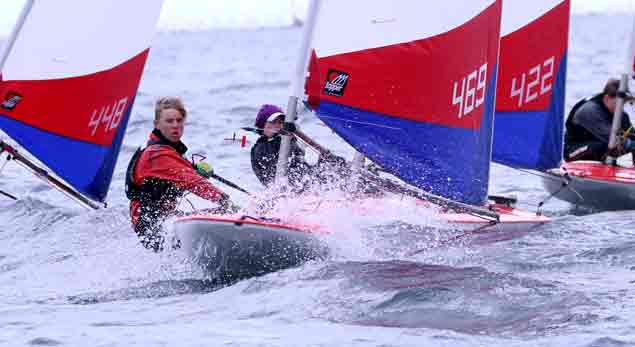 Rob Keal of Royal Cork is the Topper leader Photo: Simon McIlwaine
Rob Keal of Royal Cork is the Topper leader Photo: Simon McIlwaine
Full results are here. Optimist trials results may be found here.
In the evening, Rio Olympic Silver medallist Annalise Murphy gave the young audience some great reflections of her journey from the Optimist Trials through the various Pathway Championships in her Laser Radial and what it took to medal in Rio after the disappointments of London. There were lots of tidbits for the competitors to remember and Annalise revealed the level of commitment required with some of the extracts from her training diary started at the age of 13.
Day 3 of the racing starts tomorrow at 11:00 for all classes. The Championships finish on Sunday.
Show of Youth Sailing Strength for Royal St. George As Big Breeze Forecast for Junior All–Irelands
Tomorrow's All Ireland Junior sailing championships looks like it will get off to a wet and windy start for the 16–nominated junior sailing stars drawn from seven yacht clubs from around the country.
The Under–18 championships is scheduled to race over two days in West Cork's own TR3.6 two handed dinghies but the weather forecast for the Schull venue shows winds topping 40–knots for Saturday and the same again on Sunday.
 XC weather forecaster shows big winds in Schull, West Cork tomorrow
XC weather forecaster shows big winds in Schull, West Cork tomorrow
In a show of strength for Dublin's Royal St. George Yacht Club more than a third of the participants are drawn from the Dun Laoghaire club. RStGYC juniors are representing the RS200 (Toby Hudson Fowler), the RS Feva (Henry Start), Laser 4.7 (Peter Fagan), Optimist (Tom Higgins), Topper (Jack Fahy) and Kate Lyttle from the 420 class.
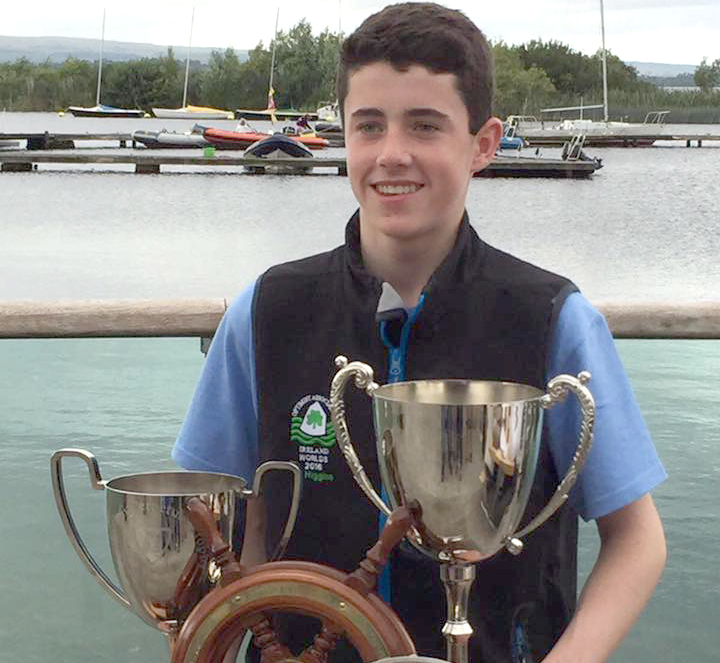 Multi–champion in the Optimist class, Tom Higgins from the Royal St. George, is nominated for this weekend's All Ireland Juniors in Schull
Multi–champion in the Optimist class, Tom Higgins from the Royal St. George, is nominated for this weekend's All Ireland Juniors in Schull
Royal Cork Yacht Club is the next biggest club on the water in Schull with four sailors involved. 29er skipper Harry Durcan and twin Johnny representing 29er and Laser Radials respectively. Harry Twomey represents the Optimist class and Sophie Crosby sails for the Toppers.
The National Yacht Club's Clare Gorman represents the Laser 4.7 and will defend the girls title and the NYC's Leah Rickard sails for the Optimists.
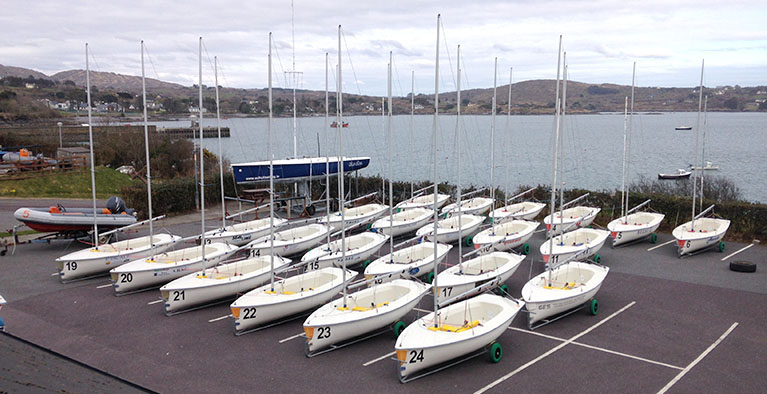 Schull's own TR3.6 dinghies ready for the junior all Ireland sailors. Photo: Fastnet Marine
Schull's own TR3.6 dinghies ready for the junior all Ireland sailors. Photo: Fastnet Marine
The West coast is represented by three clubs.Topaz sailors Adam Byrne and Dylan Reidy representing Dingle SC and Foynes YC respectively and Sligo Yacht Club sends Mirror ace Sarah White.
The 420 class is represented by Geoff Power of Waterford Harbour Sailing Club.
Full nominee list below
| Class | Name | Surname | Club |
|---|---|---|---|
| RS200 Junior | Toby | Hudson Fowler | Royal StGeorge YC |
| RS Feva | Henry | Start | Royal St George YC |
| Mirror | Sarah | White | Sligo YC |
| Laser 4.7 | Clare | Gorman | NYC |
| Laser 4.7 | Peter | Fagan | Royal St George YC |
| Laser Radial | Johnny | Durcan | RCYC/NYC |
| Topaz | Adam | Byrne | Dingle SC |
| Topaz | Dylan | Reidy | Foynes YC |
| Topper | Jack | Fahy | RSTGYC |
| Topper | Sophie | Crosby | RCYC |
| 420 | Geoff | Power | WHSC |
| 420 | Kate | Lyttle | RStGYC |
| OPTIMIST | Tom | Higgins | RSGYC |
| OPTIMIST | Harry | Twomey | RCYC&CHSC |
| OPTIMIST | Leah | Rickard | NYC |
| 29er | Harry | Durcan | RCYC |
Kinsale Yacht Club Frostbite Prizes Awarded But No Last Race
#kinsale – Well it proved to be a Lose Lose day in Kinsale. Ireland lost in Rugby and the KYC Frostbite Series lost to the Gales!
The wind at 11.00 am was recorded at a mere 10 knots so the Committee boat headed out to set a course. However as the windward mark was about to be set some 30 minutes later, the wind reading had increased to 26 knots so racing was abandoned in the interests of safety.
Several Squibs and Lasers had launched so enjoyed a blast around the harbour before heading back to the Clubhouse for the presentation of prizes for the series.
Kinsale Yacht Club Commodore Finny O'Regan gave an opening address thanking Seamus McLaverty of ASM marine for his continuing support as sponsor for the Frostbites.
He also thanked Bruce Matthews for his involvement in and support of the Frostbites going back 25 years.
Thanks were also expressed for all the Club members who helped make the Frostbites possible, from the mark-layers and safety boat personnel to those ashore in particular Caroline Forde who did sterling work on the results and weekly race reports.
June Matthews (pictured below left) presented the prize winners in each class with their trophies.
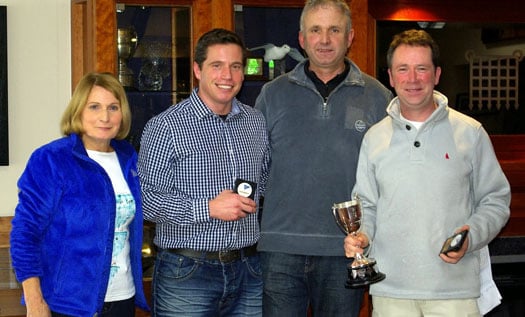
June Matthews, Rob Gill , KYC Commodore Finny O'Regan, Colm Dunne. Rob Gill & Colm Dunne receiving 1st place prize in the Squib Fleet.
The Prize winners were as follows:
Squib Class:
1st Allegro, Colm Dunne & Rob Gill KYC 2nd Lazurus, Colm Daly & Marcus Hutchinson KYC 3rd Fagin, Colm & Finny O'Regan KYC
Laser Full Rig Class:
1st Sean Murphy KYC
2nd James Long, Inniscarra
3rd Ian Travers KYC
Laser 4.7 Rig Class:
1st Billy Duane RCYC
2nd Ben Hunt KYC
3rd Jamie Tingle RCYC
Laser Radial Class:
1st Sorcha Ni Shuilleabhain KYC
2nd Cliodhna O'Regan KYC
3rd Sean Gambier-Ross KYC
Irish One-Two In Men's Laser Radial At Lake Garda
#Laser - Fionn Lyden and Robbie Gilmore made it a strong one-two finish for Ireland in the men's Laser Radial at the Europa Cup Italy regatta on Lake Garda at the weekend.
September's sailor of the month Lyden is certainly starting the year in impressive style following his runaway victory at the Junior All-Ireland Nationals in his home port of Schull - though Gilmore of Strangford Lough was hot on his heels.
Meanwhile, fourth-placed finisher Finn Lynch of the National Yacht Club - who took the title in 2011 - was just pipped to third position by Poland's Marcin Rudawski.
Further down the field were Royal Cork Yacht Club's Seafra Guilfoyle (8th) and Cian Byrne (18th), and Kinsale Yacht Club's Darragh O'Sullivan (15th) and Ross O'Sullivan (58th).
Elsewhere in the standings at the EurILCA regatta, Howth Yacht Club's Aoife Hopkins finished an impressive sixth in the Laser 4.7 for the women's best result of the four days of sailing at Malcesine.
Hopkins' achievement came with strong showings by Kinsale's Cliodhna O'Regan (14th in the 4.7) and Conor O'Beirne of the Royal St George YC (19th in the men's 4.7).
Also placing in the women's 4.7 were Baltimore's Florence Lyden (33rd) and Royal Cork's Eva Donworth (52nd).
The women's Laser Radial saw placings by Kinsale's Sorcha Ni Shuilleabhain (48th), Ausling Keller of Lough Derg YC (59th) and Chloe Eggers of the Royal St George (85th).
In the men's 4.7, Conor O'Farrell of Carlingford Lough placed 49th while Jack Higgins of the Royal St George was 107th.
In the Standard class, Colin Leonard of Ballyholme Yacht Club finished 37th while Alan Ruigrok of Rush Sailing Club was 48th.
And completing the Irish results in the men's Laser Radial were the Royal Cork's Patrick Crosbie (61st), Dermot Lyden (100th) and Mark Bolger (109th); Kinsale's Dara O'Shea (62nd) and Andrew Levie (126th); Tralee Bay's Tadhg O Loingsigh (75th); Dougie Power of Waterford Harbour Sailing Club (98th); and the Royal St George's Nathaniel Gillet (136th) and Conor Foley (155th).
The complete rankings from the Europa Cup Italy regatta are available HERE.




























